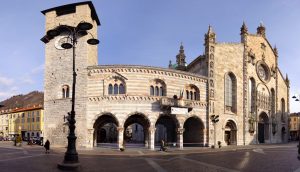
Go back in time in Como Square
In his ingenious and provocative book “The idea of Europe”, French essayist George Steiner argues that Europe is its cafés, from the Lisbon coffee house so beloved of Fernando Pessoa to the cafés of Odessa, from those in Copenhagen, which Kierkegaard past on his concentrated walks, to those of Palermo. But, the academic argues, Europe is also the continent of the square, on which of course many of the most beautiful cafés in the world are located. The little towns of Lake Como are living proof of this. Visitors will discover how the beating heart of each of these towns is the square, a meeting place, a place for socialising, greeting and sharing.
But it is in Como, whose first human settlements date back to the 13th century, that the idea of the square really reaches its triumphant apex. Piazza del Duomo is at the centre of one of the most remarkable pedestrian islands in Italy, a large space which, in addition to the Duomo, also houses prestigious monuments such as the medieval Broletto, the neoclassical Teatro Sociale and Palazzo Terragni, a masterpiece of early 20th century rationalist architecture. A space opposite the Lake that offers visitors the unrivalled wonderful views of both Gothic and contemporary architectures within just a few hundred metres of each other.
The same wonder and excitement can be felt when entering the Duomo. In fact, visiting this building is like taking a trip back in time through the city’s artistic and cultural history, an experience also offered by many other major Italian monuments. A journey into the history of art which begins with the remains of the Roman era, develops with the Gothic details of the facade, traverses the Renaissance with its paintings and, finally, leaves us in the Baroque period and the 18th century thanks to the decorations and the cupola.
For us, this is the best reason for visiting the Duomo as an experienced traveller: the chance to walk along its aisles and admire the spectacular transition from one style to the next. The experts who comment on this superb Italian interpretation of the Gothic write: “the vertical tension of the building is mitigated by the expansion of the horizontal spaces, and the effect culminates – in the choir area – in the rational introduction of Renaissance influences”. And here we see the miracle of the transition from the Gothic construction approach to the architectural language of the Renaissance. Times, styles and tastes are merged into one. You don’t need to be an expert to make out this wonderful transition, which the fine and tasteful interventions of subsequent centuries acknowledged and respected.
Leaving the Duomo you return to the square with its shops and boutiques, its open-air cafés that offer travellers or the curious the magical experience of contemplation as Baudelaire intended it when he invented the expression flaneur, the gentleman who freely wanders the streets of the city, enjoying the pleasurable emotions conjured by the landscape and manmade architecture. In those that are able to interpret them, of course. In the experienced traveller who at Lake Como discovers the magical feeling of being perfectly at home.
